

Is this study legit? 5 questions to ask when reading news stories of medical research. Who doesn’t want to know if drinking that second or third cup of coffee a day will improve your memory, or if sleeping too much increases your risk of a heart attack?

We’re invested in staying healthy and many of us are interested in reading about new research findings to help us make sense of our lifestyle choices. But not all research is equal, and not every research finding should be interpreted in the same way. Nor do all media headlines reflect what was actually studied or found. So how can you tell? Keep these five questions in mind when you’re reading media stories about new studies. Check, Please! Starter Course. Creating sub-collections in your school library. For most of us school librarians, school’s out for the summer!

Even if we’re working summer school, the pace really changes and it can be a good time to think more about big-picture changes you’d like to make in your library. How to Refine a Search According to Top-level Domain. How to Use Google Books for Research. What Is Research, Really? From an ELA point of view, “research” is something you do to gather information for a report or project.
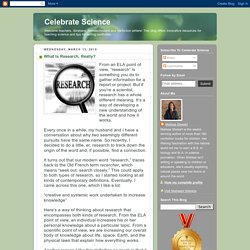
But if you’re a scientist, research has a whole different meaning. It’s a way of developing a new understanding of the world and how it works. Every once in a while, my husband and I have a conversation about why two seemingly different pursuits have the same name. So recently, I decided to do a little, er, research to track down the origin of the word and, if possible, find a connection. It turns out that our modern word “research,” traces back to the Old French term recercher, which means “seek out, search closely.” “creative and systemic work undertaken to increase knowledge” Directory of Open Access Journals. Repeat after me: Academic Databases are the Netflix for Nerds! – Dr. Kristen Mattson. As a high school librarian, I know how important it is for my students to navigate and utilize academic databases.
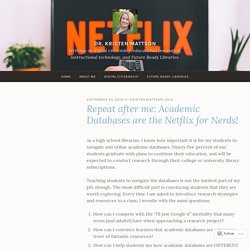
Ninety five percent of our students graduate with plans to continue their education, and will be expected to conduct research through their college or university library subscriptions. Teaching students to navigate the databases is not the hardest part of my job, though. The most difficult part is convincing students that they are worth exploring. Every time I am asked to introduce research strategies and resources to a class, I wrestle with the same questions: How can I compete with the “I’ll just Google it” mentality that many teens (and adults!) Write - Writing an annotated bibliography. The Research/Inquiry Process - Research Guide. A research project, whether it is a traditional paper, a video, or a media presentation, is the end product of a thinking process that involves student-centered questioning or inquiry.
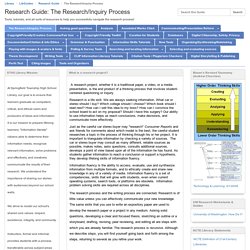
UWGB Cofrin Library. Supercharge students' digital literacy skills with content curation - SCIS. While simple collecting is additive, curation is subtractive — what is left out is almost more important than what is included.

A great way to think about collection and curation is described by Frank Chimero (2011). Consider collection as a bowl of loose pearls, and curation as a pearl necklace. The individual pearls in the bowl may be of great value, but they are pretty useless when they are just gathered together. Curation is what happens when particular pearls are selected from the bowl and strung, in a particular order, into a beautiful necklace. The necklace has fewer pearls than the bowl but, as it can be publicly admired and worn, it may be considered to have more worth. How to read a scientific paper. Nothing makes you feel stupid quite like reading a scientific journal article.
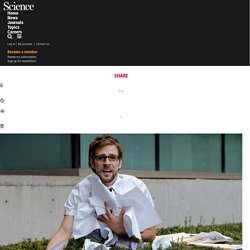
I remember my first experience with these ultra-congested and aggressively bland manuscripts so dense that scientists are sometimes caught eating them to stay regular. I was in college taking a seminar course in which we had to read and discuss a new paper each week. And something just wasn’t working for me. Every week I would sit with the article, read every single sentence, and then discover that I hadn’t learned a single thing. How to (seriously) read a scientific paper. Adam Ruben’s tongue-in-cheek column about the common difficulties and frustrations of reading a scientific paper broadly resonated among Science Careers readers.

Many of you have come to us asking for more (and more serious) advice on how to make sense of the scientific literature, so we’ve asked a dozen scientists at different career stages and in a broad range of fields to tell us how they do it. Although it is clear that reading scientific papers becomes easier with experience, the stumbling blocks are real, and it is up to each scientist to identify and apply the techniques that work best for them.
The responses have been edited for clarity and brevity. How do you approach reading a paper? I start by reading the abstract. Some of The Best Academic Search Engines for Teachers and Student Researchers.
Building Good Search Skills: What Students Need to Know. Getty The Internet has made researching subjects deceptively effortless for students — or so it may seem to them at first.
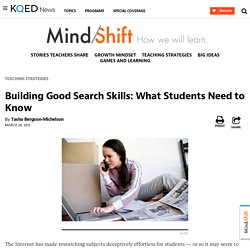
Truth is, students who haven’t been taught the skills to conduct good research will invariably come up short. That’s part of the argument made by Wheaton College Professor Alan Jacobs in The Atlantic, who says the ease of search and user interface of fee-based databases have failed to keep up with those of free search engines. In combination with the well-documented gaps in students’ search skills, he suggests that this creates a perfect storm for the abandonment of scholarly databases in favor of search engines. He concludes: “Maybe our greater emphasis shouldn’t be on training users to work with bad search tools, but to improve the search tools.”
Framework for Information Literacy for Higher Education. Filed by the ACRL Board on February 2, 2015.
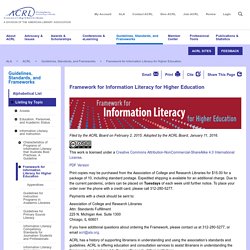
Adopted by the ACRL Board, January 11, 2016. This work is licensed under a Creative Commons Attribution-NonCommercial-ShareAlike 4.0 International License. PDF Version Print copies may be purchased from the Association of College and Research Libraries for $15.00 for a package of 10, including standard postage.
Expedited shipping is available for an additional charge. Critical Evaluation of Information Sources. Critical Evaluation of Information Sources Introduction | Evaluation Criteria | Further Reading | Acknowledgements True or false:Information that is published can be trusted because someone other than the author - an editor, a peer reviewer, a publisher, an institution - has reviewed it first. Most would probably agree with this statement, except perhaps when referring to the Internet.
Ww2.kqed. Microsoft Academic. How to spot a misleading graph - Lea Gaslowitz. Now that you have watched the video, take what you have learned and analyze the graphs below. (At the end of this section are some possible solutions) 1a. Explain at least three problems with this graph.1b. In what year was the amount of waste trashed closest to the amount recycled? 2a. 3. 26.4a. B. All graphs should be looked at carefully and not just taken at face value.
Research Strategies - AAA Shared Resource Guide - LibGuides at Indiana University-Purdue University Indianapolis. Before you start entering any search terms, spend a few minutes trying to think of as many relevant terms and combinations of terms as you can. This will help you to avoid getting stuck in a rut with the first terms that come to mind. If you need help in coming up with terms, you may want to try the "Thesaurus" or "Subject Headings" features in the database you've chosen. Check out the "Help" or "Search Tips" to learn some of the search features specific to that database.
Most databases provide similar features, but the methods may vary. Some common tricks: truncation = To use truncation, enter the root of a search term and replace the ending with an * (asterisk). Try the databases' Advanced Search feature, which usually gives you the ability to search multiple fields (author, title, keyword, subject, etc) with one search and may offer additional ways to expand or limit your search. Types of Plagiarism Infographic. LoginBuy Credits Custom Search Types of Plagiarism in Research Infographic Related Researcher Insights into the Types of Plagiarism & Attribution Issues (Interactive Chart) Buy Credits. JSTOR. Making Sense of Scholarly Journal Abstracts. Popular Literature vs. Scholarly Peer-Reviewed Literature: What's the Difference? Popular Literature Popular literature is written by journalists, who are employed by the magazine for which they write.
Journalists cover news and current events in a field, write profiles of people, places, or events, and express political opinions. Some examples of popular literature are: The New York Times Newsweek National Geographic Psychology Today Natural History The Nation New Republic Science News. Scholarly vs Popular. How to read a scientific article... How to (seriously) read a scientific paper. Learn Anything. 4 Steps to Reading Your Textbook Efficiently. Reading is definitely a huge part of learning, and there are almost no ways to avoid reading in college.
If you are taking arts and humanity subjects, you will definitely understand the need of reading textbooks efficiently. By reading efficiently, it doesn’t simply mean finishing the reading fastly. An open access resource for faculty and librarians. How to Read a Journal Article. Journal articles can be challenging to read, but most contain many of the same components. Choosing which statistical test to use - statistics help. Doing a Literature Review. Research Strategies - AAA Shared Resource Guide - LibGuides at Indiana University-Purdue University Indianapolis. Angel Teng. How people argue with research they don’t like. By Dylan Matthews By Dylan Matthews September 12, 2013. Scholarly Open Access. Bealls List: Potential, possible, or probable predatory scholarly open-access publishers. Constitute. RefSeek - Academic Search Engine. Information Timeline - MMW 121: Exploring the Pre-Modern World - LibGuides at University of California San Diego.
8 Strategies for Teaching Academic Language. “Change your language and you change your thoughts.” —Karl Albrecht Academic language is a meta-language that helps learners acquire the 50,000 words they are expected to have internalized by the end of high school and includes everything from illustration and chart literacy to speaking, grammar, and genres within fields. Think of academic language as the verbal clothing that we don in classrooms and other formal contexts to demonstrate cognition within cultures and to signal college readiness. There are two major kinds: instructional language (“What textual clues support your analysis?” ) and language of the discipline (examples include alliteration in language arts, axiom in math, class struggle in social studies, and atom in science). No student comes to school adept in academic discourse—thus, thoughtful instruction is required.
10 types of plagiarism in research. The research paradigm – methodology, epistemology and ontology – explained in simple language. I have put together this post to explain what a research paradigm is, which includes ontology, epistemology, theoretical framework and methodology, and why it is important for your research or PhD. It took me a while to understand this properly, and below is a summary of my understanding of the topic, which I hope will help you. I suggest you go easy on yourself (I was pulling my hair out on the second day). The Research Process - ELM Learning Center. Au.pinterest. Media Research Assignment. Theoretical Framework vs Conceptual Framework.